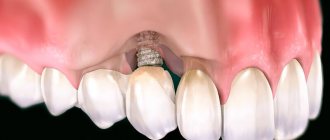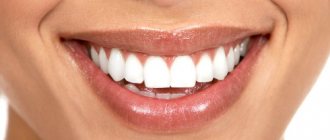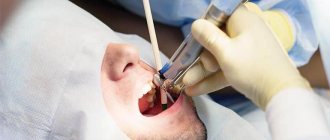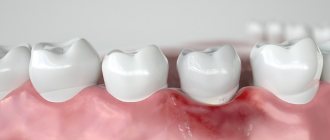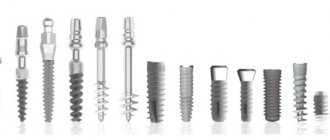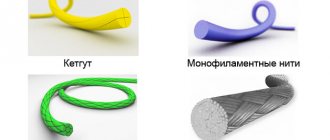- Is there pain during implant placement?
Before implanting an artificial root, the gum at the installation site is pierced or cut.
The installation site is formed using a miniature drill. An implant is installed in the resulting bed, on which the orthopedic structure is fixed. As after any surgical intervention, the postoperative period is associated with pain. Essentially, pain signals the body to pay attention to that area. In this article, we will understand what causes pain after implantation, how to reduce it, in which cases you need to seek help from a dentist, and much more.
What determines pain and discomfort during the rehabilitation period?
A few hours after the operation, the effect of the anesthetic drugs wears off and the patient may feel discomfort and pain in different areas: in the jaw and the joints closest to it, in the throat, in the frontal and temporal parts of the head.
The degree of pain varies for each patient, because... depends on several factors:
- number of implants installed (replacement of 1 tooth, full implantation according to all-on-4/all-on-6 protocols), their size (regular or long pins for zygomatic implantation);
- Everyone's pain threshold level is different;
- Implantation may be accompanied by additional procedures, for example, sinus lift.
Note
. In the vast majority of cases, pain after implantation goes away 5-14 days after surgery.
A few months after implantation
The period of complete osseointegration of the implant takes on average from 4 to 6 months. In some cases, severe pain may appear in patients many weeks after implantation of the artificial root (in the middle or late stages of osseointegration).
Causes of pain may include:
- Loosening of temporary structures
. This is either a plug (for two-stage implantation) or an abutment for a temporary crown (for one-stage implantation). This situation is not dangerous, but requires immediate contact with an implantologist to remove, wash and firmly fix the structures in their original place. - Implant failure
. During the period of osseointegration, there is a minimal chance (1%) of rejection of the structure. If detected, it is necessary to remove the implant and choose the same method of restoring the dentition. - Inflammation of the gums
. In the vast majority of cases, it occurs due to non-compliance with the implantologist’s instructions. Immediate contact with your doctor is required (the sooner the better), because inflammatory processes can lead to implant rejection. - Damage to the maxillary sinuses or mandibular nerve
during implantation (to exclude such damage, a thorough examination is carried out).
Treatment
Based on the examination of the tooth, the orthopedic dentist will select treatment.
First stage
— removal of the crown if there is an inflammatory process underneath it. When it is removed, it becomes deformed and cannot be reinstalled.
Second phase
— tooth canal treatment and sanitation are carried out. Conducted by a dental therapist. After this, an appointment is made with a prosthodontist, who will install a new crown or CEREC dental module.
The reason a living tooth reacts to hot and cold is caries. You know very well how caries is treated: the doctor uses a special bur to eliminate caries until the tooth tissue is clean. Next, if necessary, the tooth is covered with filling material.
If the so-called pain responds. a dead (previously pulpless) tooth without a nerve, then in this situation we can talk about an inflammatory process around the tooth. The dentist cleans the tooth, removes the filling material, and administers the medicine. Everything is not done in one visit. The patient is prescribed drug therapy. If at a subsequent visit there is no inflammation, then the canals are sealed and a permanent filling is placed. The tooth is ready for new prosthetics.
After fixing the prosthesis
Sometimes after the prosthetic stage, discomfort (or even pain) occurs in the gum area. The reasons may be:
- a crown that was made incorrectly or was not ground sufficiently;
- fixation of an orthopedic structure that was not completed;
- failure to comply with the instructions of the treating dentist while wearing a temporary prosthesis.
If for some reason discomfort begins to be felt after leaving the dentist (for example, after the anesthesia wears off), you need to see him as soon as possible for correction or proper fixation of the orthopedic structure.
If the implant hurts after a year
Dentists rarely encounter unusual situations when toothache in the implant area occurs only a year after the intervention. Then we are talking about long-term negative consequences of previous treatment, such as:
- Peri-implantitis . Inflammation occurs along the perimeter of the implanted titanium pin. The problem arises if the doctor violated the basic rules of prosthetics or if the patient did not pay due attention to dental care. The infection affects hard and soft tissues and leads to bone resorption. If timely treatment is not carried out, the dental implant will be rejected.
- Rejection of a titanium pin. This doesn't happen often. The fact that the body is rejecting the implant can be understood by the following signs: increased body temperature, swelling in the area of the artificial tooth, loosening and mobility of the prosthesis, separation of pus from the gums.
Both described reasons require urgent receipt of qualified dental care. These are not situations where you can delay treatment.
How can I reduce or prevent pain during recovery?
After the operation, the implantologist describes in detail mandatory recommendations that will help you better endure the recovery period and prevent the occurrence of pain.
The list is always individual, but several general points stand out:
- Regular use of painkillers. Advice: Take the first dose of the drug before the anesthetic wears off;
- use of anti-inflammatory and antiseptic agents and mouth rinses;
- To reduce swelling, and therefore discomfort, it is necessary to apply ice to the cheek;
- sleep more often. Tip: while sleeping, rest on your back or on the side opposite to the operated one;
- Do not eat spicy, salty, hard or food of critical temperatures, so as not to injure the operated area and increase swelling.
Note
. In the first two months, the artificial root is especially vulnerable, it is important to follow all the instructions of the treating dentist!
How to treat a tooth under a crown
Not every therapy method can be applied to a dental unit covered with a prosthesis. In many cases, it needs to be removed, and only then can the problem be fixed. Filled canals, installed pins, and inlays are also difficult. If there is serious inflammation and complications, treatment can take up to several months.
First aid
What to do if your tooth suddenly hurts:
- take medications that relieve pain and inflammation (painkillers, non-steroidal drugs);
- every three hours, rinse your mouth with a solution of soda, antiseptics, pharmaceutical herbal tinctures or homemade herbal decoctions;
- Contact your dentist as soon as possible.
It is strictly forbidden to make hot compresses or heat the site of inflammation, or take antibiotics. It is not recommended to sleep without a pillow, as unimpeded blood flow is necessary.
Medicines for pain relief
Even severe toothache can be relieved with painkillers. This can be any product from the first aid kit. Dentists recommend using Ibuprofen, Ketanov, Tempalgin, Ketofril or Ortofen. There is no need to suffer from a painful symptom if there are medications available. Take strictly according to instructions.
Safe folk remedies
Immediately after dentures, many patients experience minor pain and swelling of the gums. During this period, it is possible and even recommended to rinse the mouth with decoctions of medicinal herbs. It is important to coordinate traditional medicine methods with your dentist in advance.
Can be used:
- Sage. Stops bleeding, kills germs, relieves pain. Rinse your mouth with warm infusion every 4 hours. To prepare a therapeutic rinse, place one tablespoon of dry raw materials in a container and pour 250 ml of boiling water.
- Calamus root. Perfectly relieves pain and disinfects. The decoction is prepared similarly to sage. Can be used for rinsing and application. The dry root is applied to the inflamed area and left until the fibers soften.
- Oregano. It has antiseptic, antifungal properties and relieves pain. The decoction is prepared at the rate of 2 tablespoons of dry raw materials and 250 ml of boiling water. You can rinse your mouth up to eight times a day.
- Soda. The simplest remedy that is in any kitchen. Dilute a heaping teaspoon in a glass of warm water. Rinse every 2 - 3 hours until acute symptoms subside.
When is it necessary to urgently consult a dentist?
Although pain and swelling are normal, during the rehabilitation period you need to be especially attentive to your internal sensations. If you notice the following symptoms, you should immediately contact your treating dentist-implantologist:
- constant incessant bleeding from the surgical area;
- temperature from 38°C on the 4th day (or later) after surgery;
- pain that cannot be relieved with analgesics;
- large swelling;
- any pain or discomfort that appears on the 10th day (or later) after implantation;
- the appearance of sharp or aching pain in the later stages of osseointegration or after it.
Questions and answers
Do you feel pain during implantation?
In short, no. With any protocol, anesthetic drugs are used to help the patient not feel pain. During implantation, only a physical impact on the jaw is felt and nothing more.
What you can and cannot eat after dental implantation
During the rehabilitation period, you need to be especially attentive to your diet - this is an important condition for a quick recovery.
For at least 3 weeks after implantation, you must follow the following diet:
- avoid food at critical temperatures so as not to injure the mucous membrane;
- eat only soft or liquid food, puree it if possible or buy baby food;
- give preference to foods that contain a lot of calcium;
- to drink a lot of water;
- exclude seeds, nuts, spicy, salty and sour foods.
What to do if a neighboring tooth, head or ear hurts after surgery?
People often search for these areas of pain after implantation on the Internet. What to do in each case?
If in the first 2-3 days after implantation there is pain in the head or ear, there is no need to worry. Anesthetic drugs are prescribed just for such cases. If the pain does not stop by day 4, you should consult your dentist. One possible reason is an allergic reaction to the metal of the implant.
The cause of pain in the adjacent tooth after implantation may be:
- non-compliance by the patient with the recommendations of the treating dentist, which leads to gum inflammation. With timely treatment, drug treatment is possible;
- damage to the nerve ending. Indicates the unprofessionalism of the attending physician;
- an implant that is too close to an adjacent root. After a while, the discomfort will not disappear; only surgical intervention will help;
- coronal part. The situation when the crown is not polished enough is rare in new patients, because... Such a problem becomes known to the dentist's office and must be addressed on the spot.
Expert opinion Alexey Isaevich Yakubov Chief physician, orthopedic dentist, implantologist Experience 21 years
I vouch for the high quality of treatment and give a triple guarantee for the installation of dental implants. Contact us and see for yourself!
Habits that ruin your teeth every day
| Poor canal filling. If necessary, before installing a crown, the doctor removes the neurovascular bundle (pulp) and then fills the dental canals. If the canals are severely curved or the doctor does not have enough experience, then mistakes may be made during the procedure, which can cause pain in the tooth. These include:
It is important that before and after canal treatment the dentist takes targeted photographs - this is the only way to identify all the shortcomings | |
| Poor quality materials. Poor filling material begins to settle and does not adhere so tightly to the walls of the tooth, thereby eliminating the tightness. Sometimes the filling cracks, and through these micro-cracks an infection enters the tooth, which causes the development of caries under the crown. | |
| Perforation of the root wall. If the roots are severely bent, the doctor may not calculate the force of pressure on the drill. As a result, the channel is drilled through. If the error is not corrected, the infection can penetrate into the tooth from below and lead to caries. Perforation can also occur if the pin is not installed correctly. | |
| Fracture of the instrument in the canal. The disposable root canal drill is very thin and fragile. If the channels are strongly curved, then with strong rotation and awkward movement of the doctor, the tip of the instrument may break off. There are other reasons why a foreign body remains in the canal:
| |
| We recommend taking a panoramic photo of the jaw (OPTG) before installing a crown. It will allow you to timely detect deformation of the canals, the presence of inflammation and particles of instruments in the canal. | |
| Incorrect crown size. There are several reasons for this: an error during taking impressions; deformation of the material from which the impression is made; the crown was installed without fitting;; The dental technician did not correct the defects after trying on the crown. | |
| Error in crown installation. The crown does not fit tightly to the tooth, or it is installed without taking into account the bite - it can be too high or low - this injures the antagonist teeth. | |

